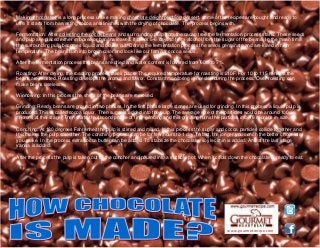
How chocolate is made
- 1. www.gourmetrecipe.com Making chocolates is a long process unlike making chocolate delight pudding dessert, some of the recipes are bought and ready to use. It starts from harvesting cocoa and finishes with the drying of chocolate. The process begins with, Fermentation: After collecting the cocoa beans and surrounding pulp from the cacao tree the fermentation process starts. These seeds and pulp are placed either in boxes or banana leaves. It takes 5-6 days to form alcohol from the sugar of the beans. In the mean time the surrounding pulp becomes liquid and drains out. During the fermentation process the seeds germinate and are killed in high temperature. The beans turn into brown color and look like our familiar cocoa seeds. After the fermentation process the beans are dried and water content is lowered from 60% to 7%. Roasting: After drying, the roasting process takes place. The required temperature for roasting is 210F. For 10 to 115 minutes the beans are roasted. Roasting develops the aroma and flavor. Constant monitoring is needed during the process. Over roasting can make beans useless. Winnowing: In this process the shells of the beans are removed. Grinding: Ready beans are ground in two phases. In the first phase large stones are used for grinding. In this process a liquid pulp is produced. This is called cocoa liquor. Then sugar is added into the pulp. The average size of the particles would be around 100 microns at this stage. Then starts the second phase of finer grinding and this grinding turns the particles into 18 microns in size. Conching: At 180 degrees Fahrenheit the pulp is stirred and mixed. In this process the sugar and cocoa particles collide together and this makes the pulp smoother. The conching process can be for few hours to 1 day. In fact, the longer you conch the better chocolate you make. In the process extra cocoa butter can be added. To stabilize the chocolate, soy lecithin is added. And at the last stage vanilla is added. After the process the pulp is taken out of the concher and poured into a suitable pot. When it cools down the chocolate is ready to eat.
